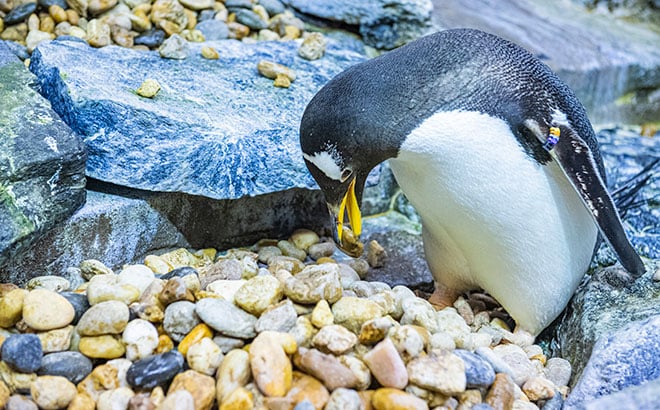Penguin Nesting Season Is Starting At Antarctica: Empire of the Penguin!
October 10, 2019
Its rookery season at Antarctica: Empire of the Penguin®, and our penguins are beginning to build their nests! Every October, we begin installing rookery (rocks and other items to help the penguins build their nests) in their habitat. We shut off two of the five snow machines and install grates – which you might see when you visit us – to allow us to better clean their home.
As soon as the rookery grate platforms arrive in the exhibit, the penguins become very excited and start picking out their nest sites; which can sometimes make installing the grates quite challenging. Once the platforms are successfully placed, sand bags and granite rock are added and it’s time to add the river rocks.
Every nesting season, several tons of river rock are added to the exhibit. Rocks are sorted by us, the Aviculturists, to pull any that might be small enough for ingestion. The rocks are dumped into milk crates, thoroughly hosed, disinfected, and carried into the exhibit for distribution.

While rocks are spread throughout the exhibit, many are left in piles in open areas so the birds can gather as they choose. They are very particular about rock size and often steal from neighbors. Some of our penguins are very creative and like to add their own special touch to their nests, using things like fish, ice chunks, and even enrichment items.

By mid-October, the small species of penguins (Southern Rockhopper, Chinstrap, Adelie, and Gentoo) begin to lay and the team conducts morning nest checks for eggs. Each of the small species will usually lay two eggs, a few days apart, per season. Depending on the species incubation can range anywhere from 32-34 days (Southern Rockhopper) all the way up to 36-38 days (Gentoo). For the small species, chicks usually start hatching late November-early December.
Around that same time, the King penguins move down to the far end of the exhibit to a large flat space. While Kings don’t build nests like the small species, they will choose a nesting location and defend it fiercely. Kings also differ from the small species, in that, they usually only lay a single egg per season. They will incubate that egg right on top of their feet under their brood patch. The brood patch is a featherless patch of skin that comes down to cover the egg and keep it warm while it rests on top of the penguin’s feet. Incubating Kings are usually quite easy to spot by the characteristic bulge the egg makes under the brood patch, but occasionally they false incubate just to keep us on their our toes. Incubation for the Kings is a bit longer than the small species, almost 2 months, 52-56 days. King chicks can hatch anywhere from January to March.

Be sure to visit us at the Empire of the Penguin to learn more about these adorable birds, and see nesting season in action!
As soon as the rookery grate platforms arrive in the exhibit, the penguins become very excited and start picking out their nest sites; which can sometimes make installing the grates quite challenging. Once the platforms are successfully placed, sand bags and granite rock are added and it’s time to add the river rocks.
Every nesting season, several tons of river rock are added to the exhibit. Rocks are sorted by us, the Aviculturists, to pull any that might be small enough for ingestion. The rocks are dumped into milk crates, thoroughly hosed, disinfected, and carried into the exhibit for distribution.

While rocks are spread throughout the exhibit, many are left in piles in open areas so the birds can gather as they choose. They are very particular about rock size and often steal from neighbors. Some of our penguins are very creative and like to add their own special touch to their nests, using things like fish, ice chunks, and even enrichment items.

By mid-October, the small species of penguins (Southern Rockhopper, Chinstrap, Adelie, and Gentoo) begin to lay and the team conducts morning nest checks for eggs. Each of the small species will usually lay two eggs, a few days apart, per season. Depending on the species incubation can range anywhere from 32-34 days (Southern Rockhopper) all the way up to 36-38 days (Gentoo). For the small species, chicks usually start hatching late November-early December.
Around that same time, the King penguins move down to the far end of the exhibit to a large flat space. While Kings don’t build nests like the small species, they will choose a nesting location and defend it fiercely. Kings also differ from the small species, in that, they usually only lay a single egg per season. They will incubate that egg right on top of their feet under their brood patch. The brood patch is a featherless patch of skin that comes down to cover the egg and keep it warm while it rests on top of the penguin’s feet. Incubating Kings are usually quite easy to spot by the characteristic bulge the egg makes under the brood patch, but occasionally they false incubate just to keep us on their our toes. Incubation for the Kings is a bit longer than the small species, almost 2 months, 52-56 days. King chicks can hatch anywhere from January to March.

Be sure to visit us at the Empire of the Penguin to learn more about these adorable birds, and see nesting season in action!


